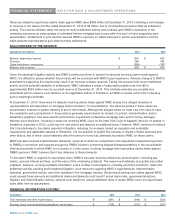GE 2014 Annual Report Download - page 166
Download and view the complete annual report
Please find page 166 of the 2014 GE annual report below. You can navigate through the pages in the report by either clicking on the pages listed below, or by using the keyword search tool below to find specific information within the annual report.
146 GE 2014 FORM 10-K
FINANCIAL STATEMENTS PRESENTATION & POLICIES
Annually, we conduct reviews of our primary pricing vendor to validate that the inputs used in that vendor’s pricing process are
deemed to be market observable as defined in the standard. While we are not provided access to proprietary models of the
vendor, our reviews have included on-site walk-throughs of the pricing process, methodologies and control procedures for
each asset class and level for which prices are provided. Our reviews also include an examination of the underlying inputs and
assumptions for a sample of individual securities across asset classes, credit rating levels and various durations, a process we
perform each reporting period. In addition, the pricing vendor has an established challenge process in place for all security
valuations, which facilitates identification and resolution of potentially erroneous prices. We believe that the prices received
from our pricing vendor are representative of prices that would be received to sell the assets at the measurement date (exit
prices) and are classified appropriately in the hierarchy.
We use non-binding broker quotes and other third-party pricing services as our primary basis for valuation when there is
limited, or no, relevant market activity for a specific instrument or for other instruments that share similar characteristics. We
have not adjusted the prices we have obtained. Investment securities priced using non-binding broker quotes and other third-
party pricing services are included in Level 3. As is the case with our primary pricing vendor, third-party brokers and other
third-party pricing services do not provide access to their proprietary valuation models, inputs and assumptions. Accordingly,
our risk management personnel conduct reviews of vendors, as applicable, similar to the reviews performed of our primary
pricing vendor. In addition, we conduct internal reviews of pricing for all such investment securities quarterly to ensure
reasonableness of valuations used in our financial statements. These reviews are designed to identify prices that appear stale,
those that have changed significantly from prior valuations, and other anomalies that may indicate that a price may not be
accurate. Based on the information available, we believe that the fair values provided by the brokers and other third-party
pricing services are representative of prices that would be received to sell the assets at the measurement date (exit prices).
Derivatives. We use closing prices for derivatives included in Level 1, which are traded either on exchanges or liquid over-the-
counter markets.
The majority of our derivatives are valued using internal models. The models maximize the use of market observable inputs
including interest rate curves and both forward and spot prices for currencies and commodities. Derivative assets and liabilities
included in Level 2 primarily represent interest rate swaps, cross-currency swaps and foreign currency and commodity forward
and option contracts.
Derivative assets and liabilities included in Level 3 primarily represent equity derivatives and interest rate products that contain
embedded optionality or prepayment features.
NON-RECURRING FAIR VALUE MEASUREMENTS
Certain assets are measured at fair value on a non-recurring basis. These assets are not measured at fair value on an
ongoing basis, but are subject to fair value adjustments only in certain circumstances. These assets can include loans and
long-lived assets that have been reduced to fair value when they are held for sale, impaired loans that have been reduced
based on the fair value of the underlying collateral, cost and equity method investments and long-lived assets that are written
down to fair value when they are impaired and the remeasurement of retained investments in formerly consolidated
subsidiaries upon a change in control that results in deconsolidation of a subsidiary, if we sell a controlling interest and retain a
noncontrolling stake in the entity. Assets that are written down to fair value when impaired and retained investments are not
subsequently adjusted to fair value unless further impairment occurs.
The following sections describe the valuation methodologies we use to measure financial and non-financial instruments
accounted for at fair value on a non-recurring basis and for certain assets within our pension plans and retiree benefit plans at
each reporting period, as applicable.
























